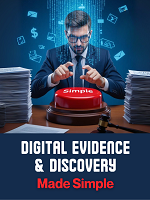
Digital Evidence and Discovery Made Simple: Practical Tips for New Technologies
If digital evidence feels overwhelming—or you’ve ever wished for a clear, step-by-step guide—this special 2-hour program is for you. Designed as a fundamentals-level roadmap, it strips away the jargon and breaks complex technology into practical tools any defense lawyer can master. Whether you’re an experienced attorney who didn’t grow up with smartphones and social media, or simply looking for a “for dummies”-style refresher, you’ll learn how to confidently recognize, admit, challenge, and exclude digital proof in today’s criminal cases.
In the first session, you’ll learn how to handle the explosion of everyday digital evidence that juries increasingly expect to see in court. You’ll discover:
- How to authenticate texts, emails, and social media posts through the creator, recipients, or witnesses familiar with the writing style.
- Why metadata and full device extractions are stronger foundations than screenshots or printouts.
- Practical examples of digital alibis, such as Netflix viewing logs, router and Bluetooth data, and app tracking histories.
- Strategies for challenging reliability and authenticity when evidence has been manipulated, altered, or selectively presented.
- Ways to anticipate and confront emerging threats like deepfakes, AI manipulations, and VR reconstructions by tying admissibility arguments to core evidentiary principles of relevance, prejudice, and authenticity.
In the second session, the focus shifts to forcing transparency in cases involving forensic software and novel investigative technologies. You’ll walk through real case studies in DNA software (Pickett), facial recognition (Arteaga), and ShotSpotter (Gutierrez) to see how defense lawyers can turn discovery battles into victories. Practical strategies include:
- Drafting tailored discovery requests that demand source code, algorithms, lab protocols, development history, and analyst notes—not just vague “results.”
- Using protective orders to overcome the state’s “trade secret” objections while ensuring your experts have meaningful access.
- Collaborating with two kinds of experts: technical experts (software engineers) who can evaluate source code, and content experts (DNA scientists, eyewitness ID researchers) who can expose flawed interpretations.
- Building a record that shows judges why black-box technology cannot be cross-examined, and why withholding discovery undermines the defendant’s constitutional right to confront evidence.
- Leveraging analogies judges understand—psychics, snitches, or flawed eyewitness IDs—to make clear why discovery is indispensable, even when the state claims it won’t introduce the software at trial.
Most importantly, you’ll gain a repeatable litigation formula: start with a comprehensive discovery request, move to compel when the state resists, fight for protective orders that guarantee meaningful access, and appeal when necessary. Even when you don’t get the materials, the strategy often succeeds—forcing the state to withdraw unreliable evidence rather than expose its flaws. Together, these sessions give you both the trial-level skills to admit or exclude digital exhibits and the litigation strategies to confront forensic software head-on. You’ll leave equipped with practical tools to challenge unreliable evidence, exploit weaknesses in state investigations, and preserve your client’s constitutional rights in the face of fast-changing technology.
Presentations Included:
- Navigating the Evolution: Admitting Evidence in a Digital World | Melanie Foote
- Forcing Their Hands: Discovery Litigation and Novel Forensic Technology | Tamar Lerer
Prices
- List Price $49.00
- Member Price $39.00